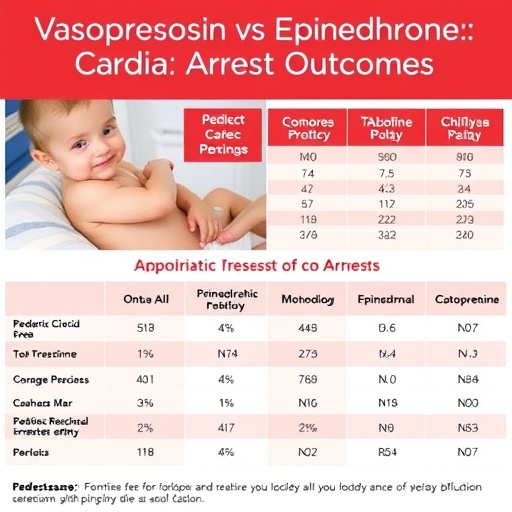In a groundbreaking advancement poised to influence pediatric emergency medicine, recent research has shed new light on the comparative efficacy of vasopressin versus epinephrine during in-hospital cardiac arrest in children. This meticulous study ventures beyond conventional paradigms, evaluating the physiological responsiveness and survival outcomes linked to these two critical vasoactive agents. As cardiac arrest remains a paramount challenge within pediatric intensive care units globally, unraveling nuanced differences between these interventions could substantially shift clinical protocols and enhance patient survival trajectories.
Understanding the intricacies of pediatric cardiac arrest interventions necessitates a deep dive into the pharmacodynamics of epinephrine and vasopressin. Epinephrine, a long-standing cornerstone of resuscitation efforts, acts predominantly through alpha- and beta-adrenergic receptor stimulation, elevating coronary and cerebral perfusion pressure. However, despite its widespread use, epinephrine’s effects on microcirculatory flow and potential to exacerbate post-resuscitation myocardial dysfunction remain topics of ongoing debate among clinicians and researchers alike. Vasopressin, contrastingly, operates via vasopressin receptors, inducing vasoconstriction independent of adrenergic pathways, which presents a compelling alternative mechanism warranting rigorous exploration.
The study conducted by Loaec et al. undertakes a robust comparative analysis within a pediatric cohort experiencing in-hospital cardiac arrest. Employing a comprehensive approach, the researchers meticulously recorded survival rates alongside detailed physiologic parameters post-resuscitation. Their methodology integrates real-time hemodynamic monitoring, allowing acute insight into the responsiveness of the vascular system following administration of either vasopressin or epinephrine. This level of granularity enables a critical evaluation not solely of survival statistics but also of underlying mechanisms dictating efficacy.
Central to the investigation’s significance is the focus on pediatric patients—a demographic often underrepresented in cardiovascular emergency research. Children present unique physiologic and pathophysiologic characteristics that can substantially alter drug pharmacokinetics and dynamics. Therefore, extrapolating adult data has always posed risks of either undertreatment or overtreatment. This study’s targeted pediatric lens addresses a conspicuous knowledge gap, acknowledging that optimal resuscitative strategies may diverge markedly between age groups due to developmental differences in receptor distribution, myocardial resilience, and systemic vascular resistance.
One compelling revelation from the study details the comparative survival outcomes across varying etiology and severity strata. The data suggest that vasopressin administration correlates with improved survival in certain subsets of pediatric patients, potentially attributed to its more sustained vasoconstrictive profile and lesser propensity to cause detrimental tachyarrhythmias. These findings provoke critical discussion about the potential re-evaluation of current resuscitation guidelines, which predominantly emphasize epinephrine as the first-line agent during pediatric cardiac arrests.
Moreover, the trajectory of physiologic responsiveness documented offers unprecedented insights into real-time vascular and cardiac system responses. Notably, vasopressin appeared to sustain mean arterial pressure more consistently in the immediate post-resuscitation phase, a period notoriously vulnerable to hemodynamic instability and end-organ ischemia. Conversely, epinephrine’s effects, while initially more pronounced, displayed a rapid decline, accompanied by significant fluctuations, which may underpin some adverse outcomes observed clinically.
The potential implications of these findings stretch beyond immediate survival. By influencing the hemodynamic milieu in the critical moments following return of spontaneous circulation (ROSC), vasopressin may contribute to improved neurological outcomes and reduced multi-organ dysfunction. Neuroprotection remains a critical goal in post-cardiac arrest care, with cerebral perfusion intricately linked to sympathetic and vascular tone modulation — domains heavily impacted by vasoactive drug choice.
In analyzing the broader clinical landscape, this research intersects with parallel investigations exploring adjunctive therapies and precision medicine approaches in critical care. As pediatric cardiac arrest management increasingly aligns with personalized therapeutic models, understanding patient-specific responsiveness to agents like vasopressin versus epinephrine could transform resuscitative paradigms. Tailoring vasoactive support could reduce iatrogenic injury while maximizing the likelihood of functional survival, a paramount concern in this vulnerable population.
The study’s rigor is further highlighted by its context within real-world clinical environments, contrasting with prior experimental or animal model research. Such ecological validity enhances the applicability of findings and bolsters the argument for integrating vasopressin-based protocols in specific pediatric cardiac arrest scenarios. Yet, despite promising trends, the authors underscore the necessity for larger-scale randomized controlled trials to definitively ascertain long-term survival and neurological outcomes following vasopressin administration.
Emerging questions pivot around optimal dosing regimens, timing, and possible synergistic strategies combining vasopressin and epinephrine or other agents. The intricate interplay of vasoactive drugs during the highly dynamic phases of cardiac arrest and recovery demands continued investigative finesse. Insights gleaned from this study pave the way for such nuanced protocol development, encouraging a shift from one-size-fits-all approaches toward adaptive resuscitation tailored by physiologic feedback.
It is worth noting that beyond mechanistic implications, the findings resonate with frontline clinicians’ experiential anecdotes regarding variable patient responses to standard epinephrine therapy. Integrating this empirical wisdom with rigorous data-driven evidence elevates the clinical discourse and nurtures a culture of innovation balanced with cautious optimism. Such synergy is essential when translating research breakthroughs into life-saving bedside interventions.
Furthermore, these insights hold substantial promise in shaping educational frameworks within pediatric emergency medicine training. Emphasizing pathophysiology-guided drug selection and the mechanistic underpinnings of vasoactive agents can foster deeper comprehension and potentially improve decision-making during high-stakes resuscitation scenarios. The study inherently advocates for ongoing clinician engagement with emerging data and flexible incorporation of novel evidence-based practices.
In conclusion, this meticulous comparative study challenges traditional conventions by presenting compelling evidence that vasopressin may not only rival but in specific contexts surpass epinephrine in optimizing pediatric in-hospital cardiac arrest outcomes. While further validation is requisite, these findings illuminate pathways toward refined resuscitation protocols aligned with the unique dynamics of pediatric physiology and critical illness. Ultimately, advancing our pharmacologic arsenal against pediatric cardiac arrest represents a beacon of hope for enhanced survival and quality of life in this vulnerable population.
Subject of Research: Pediatric in-hospital cardiac arrest resuscitation drugs – vasopressin versus epinephrine
Article Title: Comparison of vasopressin to epinephrine during pediatric in-hospital cardiac arrest: survival and physiologic responsiveness
Article References:
Loaec, M., Keim, G., Graham, K. et al. Comparison of vasopressin to epinephrine during pediatric in-hospital cardiac arrest: survival and physiologic responsiveness. Pediatr Res (2025). https://doi.org/10.1038/s41390-025-04374-6
DOI: https://doi.org/10.1038/s41390-025-04374-6




